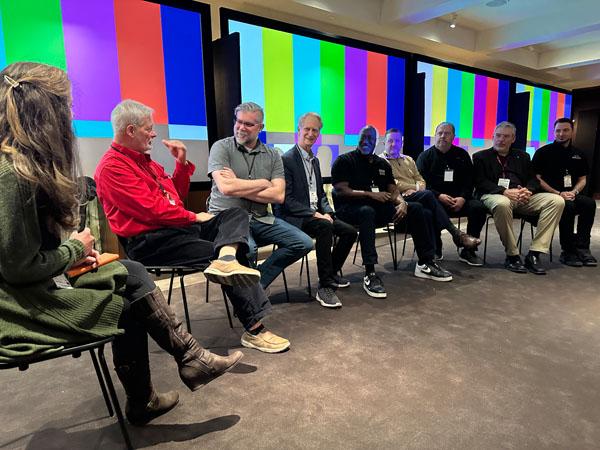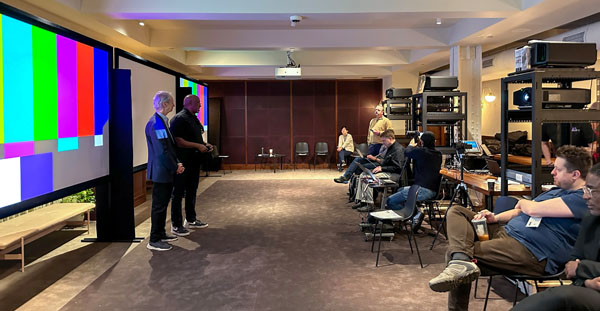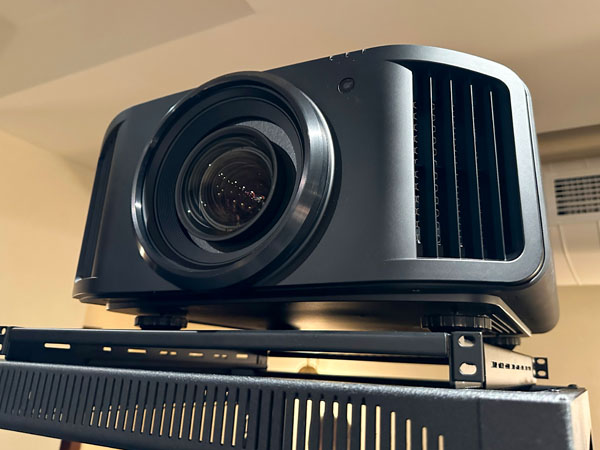King(s) of Long Throw Projectors Crowned

The host for the event was Philip Jones, the owner, Technical Editor, and Lead Reviewer at ProjectorReviews.com. Jason Dustal of Murideo, who is an ISF instructor, ensured that the nine projectors featured in the shootout were all set up properly and handled the media and technical aspects of running the shootout. Test material included a mix of scenes from movies, clips specifically designed for video analysis, as well as test patterns.

Before discussing the results, there are a few things to note. First and foremost, the projectors in this shootout were not professionally calibrated. Instead, the decision was made by the organizers to find the best combination of settings using what's available out-of-the-box, not just the raw defaults but also not adjusted using a meter. However, colorimetry was utilized to identify the best-performing picture modes. Therefore, a notable caveat for this whole experience is that some aspects of the official results (but certainly not all) apply more to a projector shopper who has no intention of ever getting a professional calibration.
Related to the lack of calibration is the fact that there was no calibrated reference display. This has significant implications when attempting to judge the accuracy of imagery, for example, skin tones. Without a calibrated high performance display as a point of reference, it's impossible to tell which projector is technically accurate in terms of tonality.

Without a calibrated reference, you can choose which one you like the most but not what's the most accurate.
Something else to know is that the comparisons took place in a large room with white ceilings, using 120-inch 16:9 1.0-gain white screens (Radiant White material by Seymour Screen Excellence) that have no ambient light rejection. Now, if a projector already exhibits poor black levels, this setting won't make any difference. But for projectors with good black levels, it's worth remembering that a dark dedicated home theater is what you need to get the most out of the top-of-the-line models featuring the highest contrast ratios and deepest black levels. But even with some light pollution, the relative differences between the projectors were readily apparent.
JVC Sweeps the Competition
The main news of the event is that JVC won each of the three Shootout categories. Based on the criteria, conditions, and materials used to evaluate the projectors, it is no surprise that JVC emerged as the winner, especially with the NZ8 and NZ9 models covering the high-end. In addition to edging out the competing Sonys for black levels, the JVC projectors often do a visibly better job with HDR content, sometimes dramatically. But that doesn't mean there's nothing more to glean from the results.
A Photo Finish for the $4000-$7000 Category
Before the evaluation part of the event even began, host Robert Zohn gave a speech and made a salient point that you can arrive at different conclusions than the judges using the category scoring, basing it on your own needs. And this is the perspective from which I have concluded the real news is that the Sony XW5000ES ($6000) scored an 8.9 to the JVC DLA-NP5 ($7000) which got a 9.0 overall. The point being the Sony costs a thousand bucks less and has a laser light source. That makes it a real winner in terms of price/performance, and therefore value—even if it does not get to wear a crown.
While there's no question the NZ8 beat the XW6000ES and the NZ9 beat the XW7000ES, there was no clear-cut victory for the JVC DLA-NP5, only winning "by a nose" based on the specific voting criteria. Pragmatically speaking, it's a tie for performance. That's why Sony's lower initial cost and lower cost of operation (due to the laser versus the JVC's lamp) strike me as important factors and why Sony is a winner in its own right.
But the counterpoint is that—like all the JVCs in this shootout—thanks to the company's frame-adaptive HDR the DLA-NP5 is superior at figuring out what to do with tough, particularly dark HDR scenes. If the focus is strictly on movies, I can see paying extra and dealing with the lamp. But for more mixed content like live sports and gaming or an SDR-centric movie library like HD Blu-ray—and especially installations where the projector will be used daily—the longevity of the laser versus the bulb surely comes into play.
The Epson LS12000 ($5000) did not keep up with the Sony or JVC, although it tended to look good, just not quite as good. Depending on priorities, its lower cost and motorized lens might still make it a preferred option. On the other hand, the LG AU810UP ($4000) often looked embarrassingly outmatched by the other projectors due to its far poorer black levels.
JVC's NZ8 Takes Crown for $11,000-$16,000 Category
In this category, the winning JVC NZ8 has a bit more space between it and the second-place Sony XW6000ES, but in this case, there is a more sizable price gap, $12,000 versus $16,000. The judges found the Sony slightly superior to the $11,000 JVC NZ7; if that tells you anything, the differences between the projectors at this price level are rather slim, and you pay quite a bit for incremental improvements in quality.
One thing that was clear as day is the Sony XW6000ES Advanced Crisp-Focused (ACF) lens delivers shocking levels of detail; it's a huge step up from the 5000ES. The XW7000ES also uses this lens. With it, the two upper tier Sonys manage to deliver a deluge of delicious detail.
The JVC NZ9 is the Top Dog, the King of Long Throw Projectors
Here's something home theater enthusiasts already know: The JVC NZ9 takes no prisoners. Here, the victory is clear, the JVC NZ9 costs less than the Sony XW7000ES and outperforms it. But we're not talking about being beaten by huge margins here; unless you are a hardcore enthusiast, it's real nitpicky stuff that's separating number one from number two.

My takeaway is that the JVC NZ9 deserves to be crowned the undisputed King of Long Throw Projectors. You get a state-of-the-art machine for your money, the best of the best; it's even capable of ultra low latency 8K/60p (for PC gaming). In the other two price categories, there are arguments to make for choosing each of the Sony projectors, so long as you bring the price/performance ratio into the discussion.
But as far as this shootout and the official judging goes, it's a clean sweep for JVC, and the top dog NZ9 is the undisputed champ.
Notes from the Shootout
It was great to see the same torture-test scenes play on all the projectors, whether it's ultra-dark scenes from The Batman and Game of Thrones or vivid HDR of outdoor scenes and nighttime cityscapes from the Spears & Munsil UHD Benchmark disc. Sometimes the renditions of the different projectors were close to each other, and more of a matter of personal taste than one or the other is better. Other times, the differences between projectors were enormous and obvious, even gasp-worthy, like how comparatively well all of the JVCs—equipped with the company's newest firmware—handled dark scenes from Game of Thrones in HDR.
Here are my notes from one dramatic event moment during the $4000-$7000 segment: "GOT notorious ultra dark scene, brutal JVC win, Sony a distant second, LG and Epson unwatchable; the LG, in particular, is a total washout." Ouch!
But then we looked at a scene from the movie Shadow, and for the most part, Sony and JVC were neck-and-neck on a reasonably dark, difficult-looking scene. OK, the JVC still edged out Sony because of black levels—and this was true for each price tier—but it was very close.
On totally different content, in that $4000-$7000 category, using a scene from Gemini Man (a 4K 60p HDR presentation on ultra HD Blu-ray), we focused on a woman's face while she's outside in a sunny garden. The Sony looked best, bright and natural, with the JVC close behind. The LG looked washed out, and the Epson seemed too dark and reddish. There's no escaping the fact different projectors do better with different scenes.
One interesting thing I got out of the demos is that in the $4000-$7000 category, in terms of detail rendition, it does not matter much if a projector is not native 4K and instead relies on a 10080p imager and pixel-shift tech. This is because the lenses of the entry-level native 4K models—JVC, Sony—are not as sharp as those of the higher-tier native 4K models. The total detail they put on the screen is similar to the pixel-shifting LG and Epson, at least from a normal viewing distance. One of the things you are paying for when you step up from the entry-level JVC and Sony models is better glass, meaning a lens with superior resolution. And once you scrutinize the same scenes and compare projectors, you can easily see the difference the upgraded lenses make.
Also, and expectedly when compared to HDR, SDR picture quality performance was much more consistent—especially between Sony and JVC models.
All of the Sony models had the Reality Creation feature turned on. Notably, this caused some scenes to look visibly different than on the other brands. Reality Creation is an AI algorithm that uses texture recognition to improve perceived resolution. Sometimes the effect is seamless, but sometimes it adds its own artifacts, like the high contrast lines you see in the image on the right (JVC on the left). When you turn off Reality Creation, the two images in the photo look nearly identical.

In this picture the Sony with Reality Creation turned on is on the right.
The LG struggled the most of any of the projectors, but it's also true that a lot of the time it looked perfectly fine, if not as good as the others. On a few rare occasions, with SDR, it actually looked the best among the four entry-level models. It's just that those DLP black levels are not competitive, and with dark scenes everything turn gray. Plus it had the hardest time making HDR look good. The LG would do great in a variety of applications like watching TV shows and live sports, anything generally bright and SDR, it just doesn't quite have what it takes to do home theater right.
Even though I acknowledge that an owner is more likely to spring for a pro calibration with the higher-end models, I am left wondering how the Epson would have done versus Sony and JVC if all the projectors where fully calibrated.
With test scenes and the 6000ES versus the NZ7 and NZ8, the Sony's lens delivered amazing resolution—we were standing a couple of feet from the screen, marveling at details. But the JVCs, the NZ8 in particular, pulled ahead in contrast and dark scene handling. The Sony looked awesome with bright scenes.
The dirty secret of Sony's lineup is you get almost everything the XW7000ES offers in the XW6000ES, but with 2500 instead of 3200 lumens. Ultimately, relative to what more you get, you pay a huge premium to get to the top of Sony's long throw home theater projector lineup—going from $12,000 to $28,000 is a giant leap.
The main thing I wish to convey in covering this shootout is that it helps to compare projector performance side-by-side, even if conditions are not perfect. For most of the tests and comparisons, the conditions were more than good enough to make reliable judgments. And what happened, based on the scores, is the projectors mostly ranked in line with their respective price points. The cheapest projector scored the lowest, on up, except in the top tier, where the lower-priced JVC NZ9 beat the Sony XW7000ES.

JVC walks away with the prize.
Final Scores
$4000-$7000
JVC DLA-NP5: 9.0
Sony VPL-XW5000ES: 8.9
Epson LS12000: 7.7
LG AU810PB: 7.4
$11,000-$16,000
JVC DLA-NZ8: 9.1
Sony VPL-XW6000ES: 8.8
JVC DLA-NZ7: 8.3
Over $25,000
JVC DLA-NZ9: 9.5
Sony VPL-XW7000ES: 9.1



















































